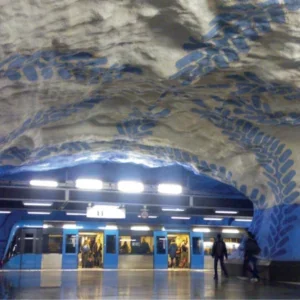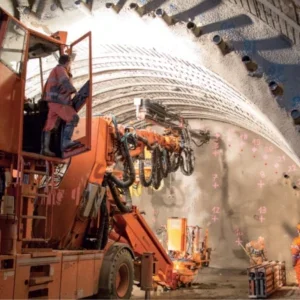While not boasting an extensive and long history in tunnelling, Denmark has been making its mark over the last two decades – not only in the TBM drives for the Storebælt link and then the immersed tube tunnel in the Øresund Crossing but also with the TBM drives for its recently built metro lines in Copenhagen. Now the city is looking ahead to the next phase of the metro – Cityringen – a 15km long loop to be built entirely underground, in twin tunnels and with 17 stations, by 2018.
A prequalification call for the civil works is to be made towards the end of this year and tender documents are to be issued around mid-2009. At this stage, it has yet to be determined if there will be two or three civil packages, but each will include tunnel and box station construction.
While the client continues with its site investigations, it anticipates that four or possibly five TBMs will be required for the project. From the geological data so far it is assumed that there will be both EPB and slurry shields on the project, and three potential locations have been identified for launch sites. The client is also considering taking relatively more risk for ground conditions compared to the first metro lines by providing its interpretation and assessment of the site investigation data.
Metro development
Copenhagen metro has two lines, M1 and M2. They were built in three phases and opened between 2002-7. Cityringen constitutes Phase 4 and will establish the M3 and M4 lines, the former running a loop, the latter a “pinched loop” on the east side of the ring. The end result will be driverless trains every 100 seconds in the east and 200 seconds elsewhere.
Studies for Cityringen were done over 2003-5, and funding was agreed in September 2005. Soon afterward a technical report was submitted for political consideration, which was quickly approved and by June 2007 the enabling legislation was passed, leaving a public enquiry for this year, as preparations mount for the construction phase.
Before procurement could get going though, there was an unconventional step – the metro owner changed. The owner Ørestad Development Corp, had a portfolio of land and rail development, and those combined responsibilities ended with its dissolution and the creation of a new metro client – Metroselskabet – on the same day, 26 October 2007. Key staff transferred, including Arne Steen Jacobsen as project director (he was project manager of design and also tender management consultant in the early phases of the metro).
Cityringen has a project programme that runs from June 2007, when the legislation was passed, and runs for 11 years in two blocks – three years for design and procurement, and eight years for construction, fit-out and commissioning. At the opening of the first phase of the metro, in 2002, early estimates of how long Cityringen would take to realise and when it would open were eight years – still with three years for design and procurement – and 2012, respectively.
The budget was set in 2005 when the technical report with project options was being drafted, and is DKr15bn (May 2005 prices – US$2.58bn at that time, almost US$3.2bn today assuming no change in local currencies but accounting for currency changes). Two-thirds of the total has been committed by the owners: Copenhagen Municipality (50%); Transport Ministry (41.7%); and, Frederiksberg Municipality (8.3%). The remaining third will be provided by debt (borrowed against future revenues).
In comparison, the first sections of the metro network were developed with underwriting by the government in the late 1990s. There was confidence in the project as the city would benefit economically from the Øresund Crossing to Sweden.
Looking farther ahead, Copenhagen Municipality is providing an extra DKr200M (US$42.3M) for studies of branch lines, and build stub tunnels.
Project management
Metroselskabet has an established project management team of 30 staff led by Jacobsen. The project manager for civil works is Jens Hieronymus Gravgaard, who was on the station design team in the early phases of the metro development and most recently was on the Citytunnel project in Malmö, Sweden (see p15).
The organisational structure has been set up for the three year long, first stage of the project. A decision has yet to be made on the construction management and supervision strategy, and its consequent organisational structure. With 150 people on project at present, including approx 120 consultant staff, everyone works in the co-located office that is also Metroselskabet’s headquarters where the metro operations unit (approx 50 staff) is also based.
With the project one year into its 11 year programme, the consultants and their respective activities, are:
- Civils: a JV of Cowi, Arup & Systra
- Rail: a JV of Ramboll/Atkins, with Parsons as subconsultant
- Areas, Rights & Utilities (i.e. preparatory works): Cowi and subconsultant LE34
- Operation & Maintenance: done by internal client staff
The client also requires the consultants to have multi-disciplinary capability to service all project needs and to be able to communicate effectively with one another. Additional contracted services include legal advisors and also the Independent Safety Assessor, TUV Rheinland with subconsultants Rovsing and DNV.
Comparatively, there are fewer distinct consultancy hires in contrast to the first phases of the metro. This is primarily because the public, and therefore the client, is settled on keeping with the concept design, and look and feel – the space, aesthetics and flow – of the initial metro lines, especially in the stations.
Procurement
Prequalification notices are to be issued by the end of this year, and the process completed in about the second quarter of 2009 – a little after the conclusion of the local authority review of plans and final input from extra site investigation.
Tender documents are to be released in about a year from now, and a negotiated procedure will follow submissions (for the first metro lines, three rounds of negotiation led to two final bidders and the winner was chosen on the final judgement of both price and quality). Contract awards on the separate rail and civil works packages are anticipated in about early June 2010.
A single contract package is planned to fit-out and operate the driverless metro transport system for approx 5-8 years, it is estimated. The contract will be for services only on M3 and M4, and is unrelated to M1 and M2, for which Ansaldo last year had its five year term extended, by a three year option, to 2010.
The civil works procurement will be undertaken differently from the first metro lines, not least because of the scale of the project. Depending on the final number of contract packages, and the boundaries, there will be up to three potential TBM launch sites for the twin bore tunnel drives:
- Cityringen’s control & maintenance site, in the south
- A park at Norrebro, in the west
- A lake near future Trianglen station, in the north, where temporary reclamation would be needed
Metroselskabet’s strategy is to have JV’s bid for individual contracts only. It will not request bids for combinations of contracts.
“They have to win them individually,” says Jacobsen, adding that they will have more than one winning option, more than one chance to win. “We know about the international market for civil works and we’re looking at how the project will appeal to contractor JVs.”
Given the increased risk sharing being considered by the client, the competitive differences between contractors are seen as being more to do with logistics, temporary works, tunnelling methods, grouting, dewatering/recharging, etc – i.e. the focus is on classic contracting output on heavy civils. The competitive margins would be calculated from the scale effects won by repeating the method of works, where possible, over multiple box stations and the approach to the tunnelling solution.
Geology and tunnels
The tunnelling conditions in the capital are relatively favourable with glacial moraine over limestone, which makes up half the alignment of Cityringen. The prime challenges are determining mass properties of the rock and the strictly controlled urban groundwater regime.
A site investigation programme involving 350 boreholes has been completed. Based on preliminary data, a further round of investigation has been decided in the northwest of the city centre, in the Norrebro area, where there is relatively more sand. Plans are being refined, and tests are underway of a coupled system of vertical (borehole) and horizontal (along streets) surveys to help determine the limestone profile. The additional probing should start in about September and will involve 50-100 boreholes as well as geophysical surveys.
In the Norrebro area, the thicker layers of sand (meltwater deposited) are either side of Clay Till (moraine) with the lower layer over the limestone at a depth of 30m-35m. From the ground surface, the sequence is: Fill/postglacial deposits: (0-10m); Upper meltwater sand: (0-3m); Upper till/Meltwater clay (0-10m); Middle meltwater sand (0-18m); Lower (Clay) till (0-8m); Lower meltwater sand/gravel (0-18 m); Copenhagen limestone (20-40m); and, Bryozoan limestone.
On one occasion, in Phase 2 of the metro, on an EPB drive through sand between Norreport and Forum stations, and with compressed air being used, there was a blow out of the bed of lake Peblingesøen.
“The difficult parts for the EPB machine lie in the coarse sand and gravel deposits,” adds Gravgaard, noting that there were no other significant incidents affecting settlement control.
Therefore, with a high groundwater level, the relatively greater presence of sand in the Norrebro area raises the possibility of using slurry TBMs for settlement control. The capability of slurry TBMs for use in limestone is also being investigated.
Unlike on the early metro phases, Metroselskabet, in considering taking on more risk, would not just give over raw data to tenderers but also its interpretation of the numbers, both for design purposes and to help deal with discussions with environmental authorities. The interpreted, or “evaluated”, data for the civil works would see the client “probably giving some global design values”, says Gravgaard, such as UCS, angle of internal friction, and how the strength of limestone is defined.
Copenhagen limestone has three subdivisions – upper, middle and lower – based upon combined markers from geophysical borehole logging, such as natural gamma, induction, resistivity and porosity. The subdivisions are characterised by five degrees of hardness (H1-H5), or induration. At the softer end, rock of H1 classification can be shaped with the fingers, H2 easily worked with a knife or scratched with a fingernail, and at the hardest, H5, there is flint. The subdivisions have different percentage distributions of H1-H5, and the upper and lower zones have more H5.
Metroselskabet will also tell contractors that the limestone is more competent than basic borehole data would indicate, thanks to facelog data during previous tunnelling works. Most fractures in core samples are due to drilling, says Gravgaard.
The existing metro tunnels are 4.9m i.d., spaced typically 20m between centrelines and a similar arrangement is anticipated for Cityringen. The M1 and M2 tunnels have six-segment, 275mm thick rings but the client is unlikely to specify such detail for the lining, nor the excavation diameter but is looking to steel fibres over rebar to improve durability and minimise damage during handling.
Contractors will be able to optimise the vertical alignment of the tunnels to minimise mixed face tunnelling as they benefit from the extra site investigation data, which is also aimed at better defining upper profiles of the limestone. Suggestions for excavation between the stations will be welcomed, says the client, noting it’s a constructability issue but that ground treatment is assumed to minimise settlement, especially for any proposals for shallower tunnelling.
Stations – special challenges
Metroselskabet is undertaking new types of geophysical borehole logging (optical and acoustic televiewer) to survey insitu rock from boreholes. Previously, the methods were used on a local district heating tunnel, completed earlier this year. It has also been used at the proposed locations of cavern excavations and for lower parts of two of the most complicated construction challenges for the stations – at Frederiks Kirke and Kongens Nytorv.
At each station, the open box construction is narrower than standard on Cityringen. At the base of the diaphragm walls excavations will be broken-out using NATM to form caverns for the platforms and pull through the TBMs for relaunch.
One of the country’s most beautiful old churches, built on timber piles in saturated strata, is Frederiks Kirke. The construction challenge arises from the proximity of the new station. The platform will be just over 24m below the surface, deeper than the approximately 18m-19m at most stations.
The challenge is added to by the need to keep the timbers below groundwater level, and therefore a major operation of dewatering and recharge will be required for the deeper than typical station excavation.
Kongens Nytorv is the capital city’s finest square and is bounded by the Royal Theatre, the main shopping street, and outside dining/café areas. In addition to the public prominence in one of the most valuable real estate arenas, the construction challenge includes connecting the new station to the existing one with a platform approximately 18m below ground surface. The plan is to go deeper, drive the new running tunnels below, but close to, the live tubes, resulting in a new platform depth of approximately 28.5m.
Going deeper at Kongens Nytorv also adds to the need for a powerful groundwater control regime. Groundwater protection is a very serious business in Copenhagen, as elsewhere in Scandinavia. In the central part of the city the level cannot be lowered due to settlement risk. It is also a zone of potential drinking water interest. In fact, even getting a permit for a drawdown pumping test proved a difficult process, comments Gravgaard. Further, there are strict and onerous limitations on insitu concrete, shotcrete and grout additives.
The scope and details of the project, and competitive build options, will become clearer over the next couple of years.
Map showing the different phases of metro development in Copenhagen Previous metro construction in Copenhagen Project programme for Cityringen Earlier tunnelling work on Copenhagen metro Cityringen will have more sands to drive through compared to earlier phases of the metro Cityringen will repeat the design for passenger space (lighter area in diagram) and the competitive construction challenge will be outside of these areas (i.e. darker areas)






